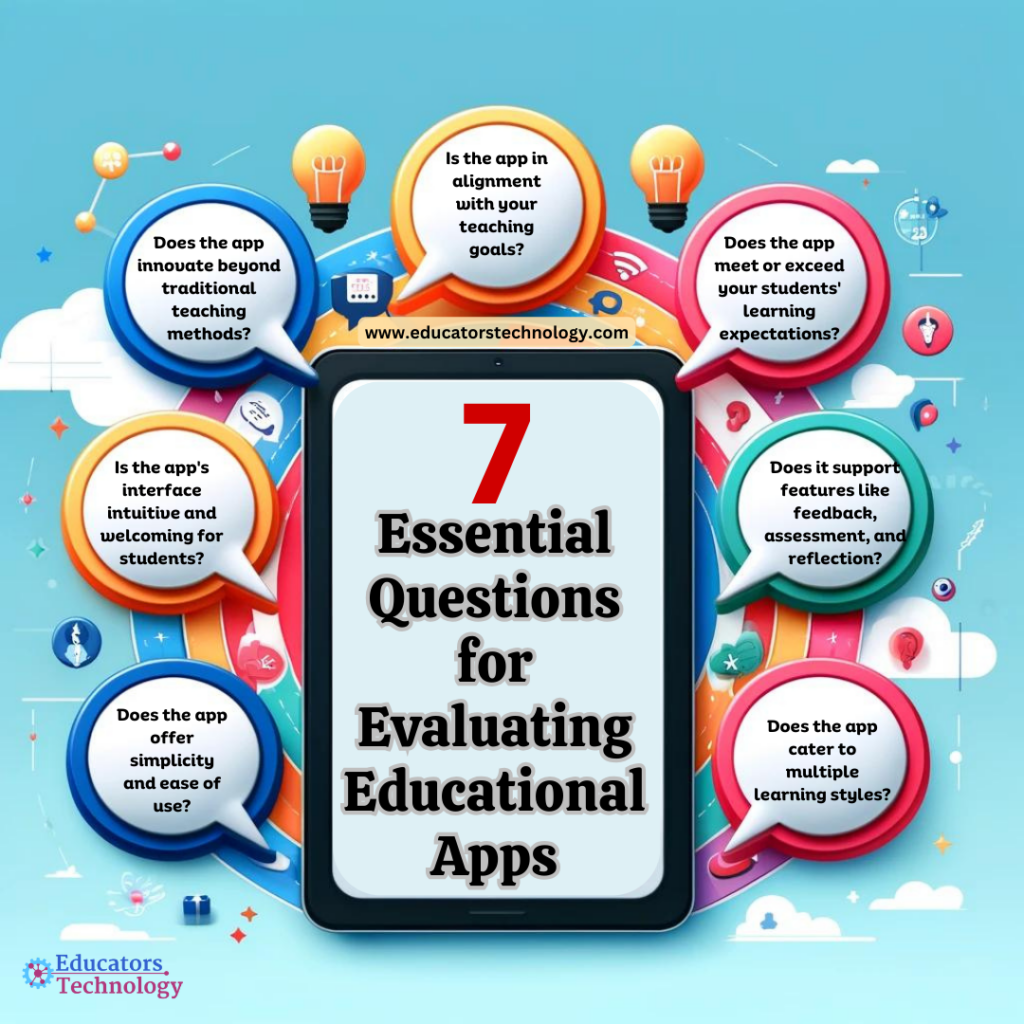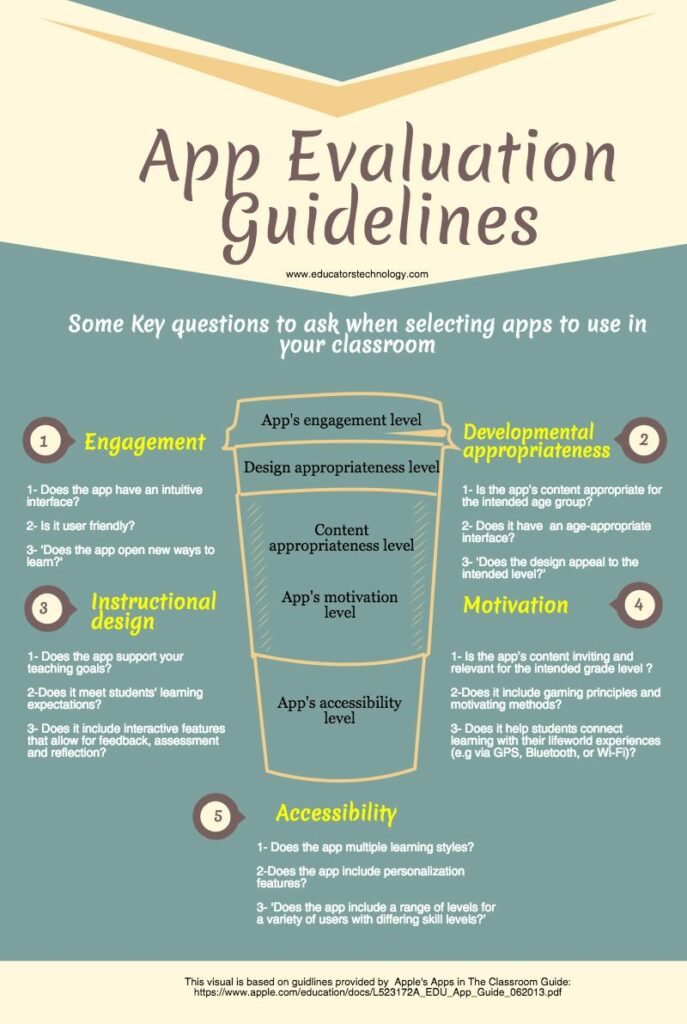As the world of mobile applications is getting richer and richer, the ability to discern which apps will truly enrich our teaching and engage our students is a key skill for teachers. It’s akin to selecting the right tools for a craftsman; the choice can significantly enhance the craftsmanship, in this case, the learning and teaching experience. In this post, I share with you these practical guidelines I put together a few years ago, which, despite the passage of time, remain incredibly relevant and useful for educators looking to navigate the vast sea of educational technology.
These guidelines are based on Apple’s recommendations for selecting educational apps, a resource that originally served as a beacon for many of us in the educational community. Unfortunately, the initial link to Apple’s PDF I used years ago is not working (htps://www.apple.com/education/docs/L523172A EDU App Guide_062013.pdf)) , and I can’t seem to find the new link to the guide. If anyone has it or knows where to find it, please share with us so the whole community benefits.
Essential Questions for Evaluating Educational Apps
Drawing from the comprehensive guidelines outlined in this post (see below), I’ve extracted 7 pivotal questions to aid teachers in their quest to evaluate and find effective educational apps:

- Is the app’s interface intuitive and welcoming for students, making navigation straightforward and learning immediate?
- Does the app offer simplicity and ease of use, ensuring that students of all technological proficiencies can engage without hurdles?
- Does the app innovate beyond traditional teaching methods, offering new pathways and opportunities for exploration and learning?
- Is the app in alignment with your teaching goals, effectively complementing and enhancing your educational strategies?
- Does the app meet or exceed your students’ learning expectations, fostering a sense of curiosity and eagerness to learn?
- Are there interactive features within the app that support feedback, assessment, and reflection, integral to the learning process?
- Does the app cater to multiple learning styles, offering personalization features to suit a wide array of students’ needs and preferences?
Related: Best Apps for Students and Teachers
Criteria for Evaluating Educational Apps
Now, let’s explore the various facets of app evaluation, from engagement and instructional design to content appropriateness, motivation, and accessibility. Each of these areas is crucial for ensuring that an app not only fits into our educational toolkit but also resonates with and supports our students’ learning journeys.
Engagement
When it comes to integrating apps into the classroom, the first checkpoint is engagement. An app must be more than just a digital placeholder in the students’ learning journey; it should captivate and hold their attention. Here’s what to consider:
- Intuitive Interface: The app should welcome students with open arms. An intuitive design means they spend less time figuring out how to navigate and more time learning.
- User-Friendly: Complexity in functionality should never be a barrier. A user-friendly app ensures that students of all tech competencies can dive right in.
- Opening New Learning Avenues: The app should not merely digitalize traditional teaching methods but open new doors to learning. It’s about creating opportunities for exploration that were previously unimaginable.
Instructional Design: The Backbone
The structural design of an app is its backbone, providing the necessary support to meet educational objectives. Consider these aspects:
- Alignment with Teaching Goals: The app should seamlessly fit into your teaching strategies, complementing and enhancing the learning experience.
- Meeting Learning Expectations: It’s essential that the app meets, if not exceeds, students’ learning expectations, catering to their curiosity and thirst for knowledge.
- Interactive Features: Feedback, assessment, and reflection are pillars of effective learning. An app should facilitate these through interactive and responsive features.
Content Appropriateness: The Foundation
The content within an app serves as its foundation, grounding the learning experience in age-appropriate and relevant material.
- Developmental Suitability: The content should be tailored to the developmental stage of its intended audience, ensuring it strikes the right balance between challenge and accessibility.
- Age-Appropriate Interface and Design: The app’s design and interface should resonate with the age group it’s designed for, making learning an inviting experience.
- Design Appeal: Beyond functionality, the aesthetic appeal of an app can significantly impact its effectiveness in engaging students.
Motivation: The Spark
An app’s ability to motivate learners is like the spark that ignites curiosity and drives engagement.
- Inviting Content: The content should speak directly to the students’ interests and needs, making learning relevant and engaging.
- Incorporating Gaming Principles: The use of game-like elements can tremendously boost motivation, making learning feel more like play.
- Connecting to the Real World: Apps that bridge classroom learning with real-life experiences tend to be more impactful, making learning more meaningful.
Accessibility: The Bridge
Accessibility ensures that the app is a bridge, not a barrier, to learning, catering to diverse needs and learning styles.
- Supporting Multiple Learning Styles: The app should cater to various learning preferences, ensuring inclusivity.
- Personalization Features: Customization options allow students to adjust the learning environment to suit their needs, making the app more accessible.
- Variety of Levels: Offering a range of difficulty levels ensures that learners at different stages can engage and benefit from the app.

Final thoughts
The guidelines and questions shared in this post, drawn from Apple Education ‘s insightful recommendations, provide a robust framework for evaluating the myriad of apps available. They serve as a compass, guiding us towards making informed decisions that enrich our educational toolkit and, most importantly, resonate with our students’ learning journeys. Despite the challenges, such as the unavailability of the original Apple guide, our collective endeavor to share knowledge and resources continues. This spirit of collaboration is what makes our community vibrant and resourceful.
The post 7 Essential Questions for Evaluating Educational Apps appeared first on Educators Technology.